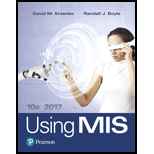
Explanation of Solution
Processes:
Processes contain sequence of interconnected activities that produces result by converting inputs into outputs.
- Activity is a sub-part of a process.
- Activities in processes include getting inputs, manipulating and producing corresponding output, which are interrelated to one another.
- Activities can be done either by human or by computer systems.
Types of processes:
There are two different types of processes. They are:
- Structured processes
- Dynamic processes
Structured Processes:
- Structured processes are standardized and they mostly contain the same and fixed sequence of activities.
- The flow of activities in structure processes does not change.
Example:
Booking flight tickets:
Here, the user enter their details and some processes takes place internally like, if the seats are available, then the tickets are produced, if the seats are not available, then the tickets are not produced for that particular flight. In this, the procedures to get tickets for all the users are same and so it is called as structured processes.
Dynamic Processes:
- Dynamic processes are not standardized. It is less structured.
- The flow of activities in dynamic processes gets change according to the current trend. It is more strategic and more adaptive.
- This type of processes needs human judgement.
Example:
Programs in TV channels:
Programs in a high rated channel get changed more frequently according to the response of the audience in order to increase Television Rating Point (TRP rate).
Differences between structured and dynamic processes:
| Structured Processes | Dynamic Processes |
| Structured processes are standardized and they are highly structured. | Dynamic processes are less structured. |
| The flow of processes does not change. | The flow of processes gets changed frequently. |
| It is formal in nature. | It is informal. |
| It supports operational activities and there is no need of human judgement in structured processes. | It supports strategic activities and so this processes needs human judgement. |
| Example: Booking flight tickets | Example: Programs in TV channels. |
Workgroup processes:
Workgroup processes achieve goals of a particular department by implementing groupwork.
Example:
Human Resources’ involvement is important in recruitment process, compensation, assessment and HR planning. The HR department in specific company gets performance of an employee from various departments and process overall rating for that particular employee.
Enterprise processes:
Enterprise processes provide the organization to sustain longer and it supports the activities performed in various departments.
Example:
In a corporate company, the process of recruiting a person supports activities in financial department, the employee’s specialized department, and so on...
Want to see the full answer?
Check out a sample textbook solution
Chapter 7 Solutions
Using MIS (10th Edition)
- Ensure you answer the question asked at the end of the document. Do not just paste things without the GNS3 console outputsarrow_forward"Do not use AI tools. Solve the problem by hand on paper only and upload a photo of your handwritten solution."arrow_forward"Do not use AI tools. Solve the problem by hand on paper only and upload a photo of your handwritten solution."arrow_forward
- "Do not use AI tools. Solve the problem by hand on paper only and upload a photo of your handwritten solution."arrow_forward"Do not use AI tools. Solve the problem by hand on paper only and upload a photo of your handwritten solution."arrow_forwardSolve this "Do not use AI tools. Solve the problem by hand on paper only and upload a photo of your handwritten solution."arrow_forward
- "Do not use AI tools. Solve the problem by hand on paper only and upload a photo of your handwritten solution."arrow_forward"Do not use AI tools. Solve the problem by hand on paper only and upload a photo of your handwritten solution."arrow_forwardSpecifications: Part-1Part-1: DescriptionIn this part of the lab you will build a single operation ALU. This ALU will implement a bitwise left rotation. Forthis lab assignment you are not allowed to use Digital's Arithmetic components.IF YOU ARE FOUND USING THEM, YOU WILL RECEIVE A ZERO FOR LAB2!The ALU you will be implementing consists of two 4-bit inputs (named inA and inB) and one 4-bit output (named out). Your ALU must rotate the bits in inA by the amount given by inB (i.e. 0-15).Part-1: User InterfaceYou are provided an interface file lab2_part1.dig; start Part-1 from this file.NOTE: You are not permitted to edit the content inside the dotted lines rectangle. Part-1: ExampleIn the figure above, the input values that we have selected to test are inA = {inA_3, inA_2, inA_1, inA_0} = {0, 1, 0,0} and inB = {inB_3, inB_2, inB_1, inB_0} = {0, 0, 1, 0}. Therefore, we must rotate the bus 0100 bitwise left by00102, or 2 in base 10, to get {0, 0, 0, 1}. Please note that a rotation left is…arrow_forward
 Fundamentals of Information SystemsComputer ScienceISBN:9781337097536Author:Ralph Stair, George ReynoldsPublisher:Cengage Learning
Fundamentals of Information SystemsComputer ScienceISBN:9781337097536Author:Ralph Stair, George ReynoldsPublisher:Cengage Learning Systems ArchitectureComputer ScienceISBN:9781305080195Author:Stephen D. BurdPublisher:Cengage Learning
Systems ArchitectureComputer ScienceISBN:9781305080195Author:Stephen D. BurdPublisher:Cengage Learning Fundamentals of Information SystemsComputer ScienceISBN:9781305082168Author:Ralph Stair, George ReynoldsPublisher:Cengage Learning
Fundamentals of Information SystemsComputer ScienceISBN:9781305082168Author:Ralph Stair, George ReynoldsPublisher:Cengage Learning Principles of Information Systems (MindTap Course...Computer ScienceISBN:9781305971776Author:Ralph Stair, George ReynoldsPublisher:Cengage Learning
Principles of Information Systems (MindTap Course...Computer ScienceISBN:9781305971776Author:Ralph Stair, George ReynoldsPublisher:Cengage Learning Principles of Information Systems (MindTap Course...Computer ScienceISBN:9781285867168Author:Ralph Stair, George ReynoldsPublisher:Cengage Learning
Principles of Information Systems (MindTap Course...Computer ScienceISBN:9781285867168Author:Ralph Stair, George ReynoldsPublisher:Cengage Learning





